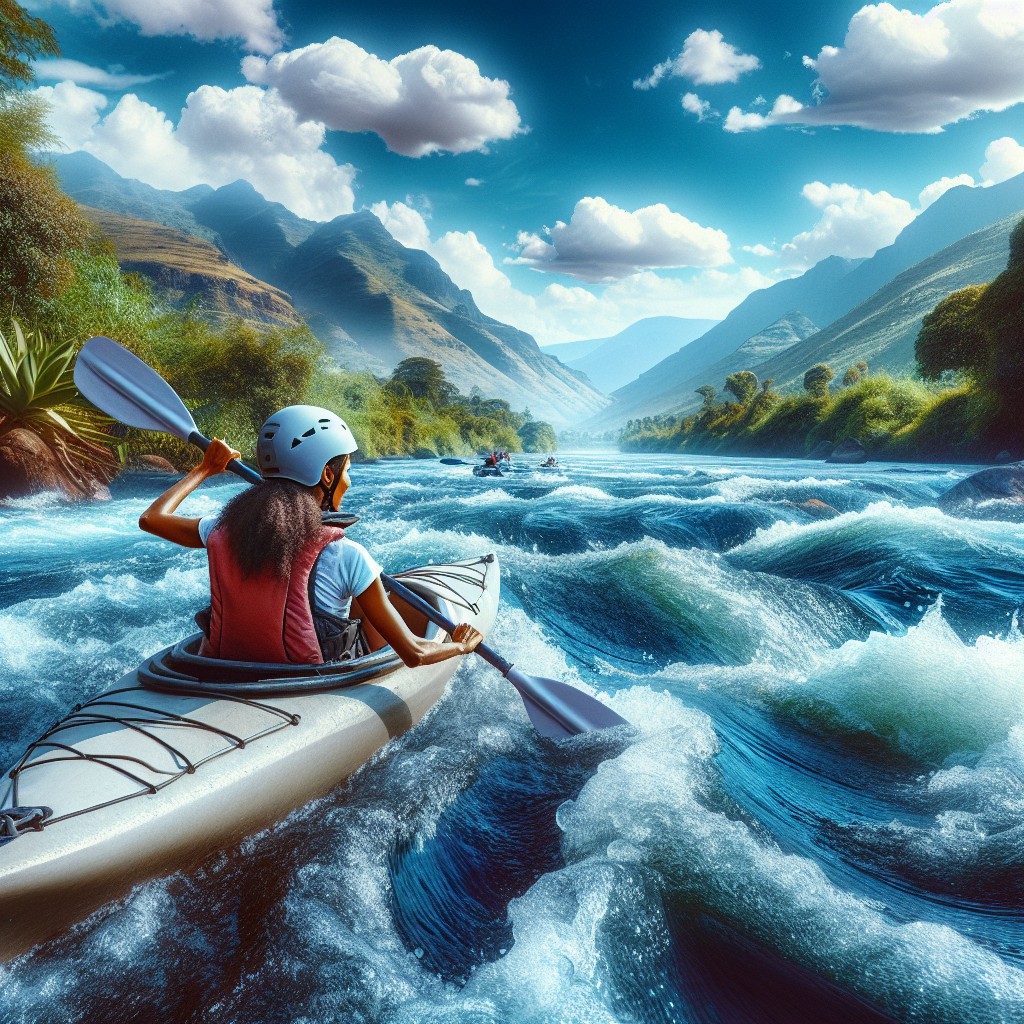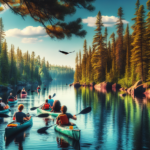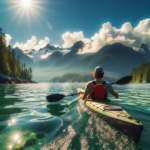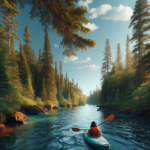Kayaking in Blue Nile River, Ethiopia
Introduction to Kayaking
Kayaking is an exhilarating outdoor activity that has gained immense popularity worldwide. It offers a unique blend of adventure, exercise, and a chance to connect with nature. Whether you’re navigating through serene lakes, challenging river rapids, or exploring coastal waters, kayaking provides a thrilling experience that appeals to both beginners and seasoned paddlers. The sport’s accessibility and the minimal equipment required make it an attractive option for those looking to embark on an outdoor adventure.
In this article, we will spotlight the unique features of kayaking in the Blue Nile River, Ethiopia. This destination stands out for its breathtaking landscapes, rich cultural history, and diverse wildlife. Our goal is to provide a comprehensive guide for kayaking enthusiasts who are considering this remarkable location for their next adventure. From the river’s geography and climate to the best spots for kayaking, we will cover all the essential information you need to plan your trip.
Kayaking in the Blue Nile River, Ethiopia, offers a unique experience that sets it apart from other kayaking destinations. The river’s powerful currents, stunning waterfalls, and lush surroundings create an unforgettable backdrop for your kayaking journey. Additionally, the region’s historical and cultural significance adds an extra layer of depth to your adventure, making it a truly enriching experience.
Overview of Kayaking in Blue Nile River, Ethiopia
The Blue Nile River, originating from Lake Tana in Ethiopia, is one of the most significant rivers in Africa. It flows through a diverse landscape that includes highland plateaus, deep gorges, and lush valleys. The river’s geography makes it an ideal location for kayaking, offering a variety of water conditions that cater to different skill levels. The climate in the region is generally warm, with a rainy season from June to September, which can significantly impact water levels and kayaking conditions.
Historically, the Blue Nile River has been a vital waterway for the communities living along its banks. It has played a crucial role in agriculture, transportation, and trade. While kayaking is a relatively new activity in the region, it has quickly gained popularity among both locals and tourists. The river’s challenging rapids and scenic beauty make it a sought-after destination for adventure seekers.
Visitors can access the Blue Nile River from various points, with Bahir Dar being one of the most popular starting locations. Bahir Dar is a vibrant city located near Lake Tana and serves as a gateway to the Blue Nile Falls, one of the river’s most famous attractions. The best time to visit for kayaking is during the dry season, from October to May, when the water levels are more manageable, and the weather is favorable.
Kayaking Conditions in Blue Nile River, Ethiopia
The Blue Nile River offers a range of water conditions that can cater to different kayaking experiences. The river is known for its powerful currents and challenging rapids, particularly in the sections near the Blue Nile Falls. These conditions make it an exciting destination for experienced kayakers looking for a thrilling adventure. However, there are also calmer sections of the river that are suitable for beginners and those looking for a more relaxed paddling experience.
The weather conditions in the Blue Nile River region can vary significantly throughout the year. The dry season, from October to May, is characterized by warm temperatures and lower water levels, making it the ideal time for kayaking. During the rainy season, from June to September, the river’s water levels rise, and the currents become stronger, creating more challenging conditions for kayakers. It’s essential to check the weather forecast and water conditions before planning your trip.
Tides and water currents are crucial factors to consider when kayaking in the Blue Nile River. The river’s flow can be unpredictable, and it’s essential to be aware of any potential hazards, such as submerged rocks or sudden changes in water levels. Local guides and tour operators can provide valuable information and assistance to ensure a safe and enjoyable kayaking experience.
Top Spots for Kayaking in Blue Nile River, Ethiopia
One of the top spots for kayaking in the Blue Nile River is the section near the Blue Nile Falls, also known as Tis Issat or “Smoking Water.” This area offers a thrilling experience with its powerful rapids and stunning waterfalls. The scenery is breathtaking, with lush vegetation and diverse wildlife adding to the adventure. The best time to kayak here is during the dry season when the water levels are lower, making the rapids more navigable.
Another popular spot is the stretch of the river near Bahir Dar. This section is known for its calmer waters, making it suitable for beginners and those looking for a more relaxed kayaking experience. The area is also rich in birdlife, providing an excellent opportunity for birdwatching while paddling. Early morning and late afternoon are the best times to kayak here, as the weather is cooler and the lighting is perfect for photography.
The section of the Blue Nile River that flows through the Grand Ethiopian Renaissance Dam area offers a unique kayaking experience. This area is characterized by its deep gorges and dramatic landscapes, providing a challenging yet rewarding adventure for experienced kayakers. The best time to visit is during the dry season when the water levels are more manageable, and the weather is favorable.
Safety and Regulations
Safety is paramount when kayaking in the Blue Nile River, Ethiopia. Local regulations require all kayakers to wear life jackets and helmets at all times. It’s also recommended to have a whistle and a waterproof map of the area. Before embarking on your kayaking adventure, make sure to check the weather forecast and water conditions. It’s advisable to go with a local guide or join a guided tour, especially if you’re unfamiliar with the river.
In case of an emergency, it’s essential to know how to handle different situations. If you capsize, stay calm and try to right your kayak. If you’re unable to do so, stay with your kayak and signal for help. It’s also crucial to be aware of the river’s currents and avoid areas with strong undertows or submerged rocks. Local guides can provide valuable information on the safest routes and potential hazards.
When kayaking in the Blue Nile River, it’s essential to respect local regulations and guidelines. This includes not disturbing wildlife, avoiding littering, and being mindful of other water users. Following these guidelines ensures a safe and enjoyable experience for everyone and helps preserve the river’s natural beauty for future generations.
Amenities and Accommodations
The Blue Nile River region offers a range of amenities and accommodations to cater to different preferences and budgets. In Bahir Dar, you’ll find several rental facilities that provide kayaks, paddles, and safety gear. Many of these facilities also offer guided tours, which can be an excellent option for those new to the area or looking for a more structured experience. Local guides are knowledgeable about the river’s conditions and can provide valuable insights into the best spots for kayaking.
Accommodation options in the Blue Nile River region range from budget-friendly camping sites to luxurious hotels and lodges. For those who prefer a more immersive experience, camping along the riverbanks can be a great option. There are several designated camping areas that offer basic amenities such as restrooms and picnic tables. For a more comfortable stay, consider booking a room in one of the many hotels or lodges in Bahir Dar. These establishments often provide additional services such as guided tours, equipment rentals, and transportation to and from the river.
In addition to kayaking, the Blue Nile River region offers a variety of recreational activities for visitors to enjoy. Hiking, birdwatching, and exploring local markets are popular options for those looking to experience the area’s natural beauty and cultural heritage. The Blue Nile Falls is a must-visit attraction, offering stunning views and excellent photo opportunities. Many tour operators offer combined packages that include kayaking and other activities, allowing you to make the most of your visit.
Environmental Considerations
Preserving the natural habitats and wildlife of the Blue Nile River is of utmost importance. When kayaking in the region, it’s essential to follow eco-friendly practices to minimize your impact on the environment. This includes avoiding littering, using biodegradable products, and being mindful of wildlife. Always maintain a safe distance from animals and avoid disturbing their natural behaviors. By following these guidelines, you can help protect the river’s ecosystem and ensure its beauty for future generations.
Several local conservation efforts and projects are in place to protect the Blue Nile River and its surrounding areas. These initiatives focus on preserving the river’s biodiversity, promoting sustainable tourism, and supporting local communities. Visitors can contribute to these efforts by participating in eco-friendly tours, supporting local businesses, and making donations to conservation organizations. By doing so, you can help ensure the long-term health and sustainability of the Blue Nile River.
When planning your kayaking trip, consider choosing tour operators and rental facilities that prioritize environmental sustainability. Many of these businesses have adopted eco-friendly practices and are committed to minimizing their impact on the environment. By supporting these companies, you can enjoy your kayaking adventure while also contributing to the preservation of the Blue Nile River.
Highlights
When comparing kayaking in the Blue Nile River, Ethiopia, with other popular kayaking destinations, several unique features stand out. The river’s powerful currents and challenging rapids offer an exhilarating experience for adventure seekers. The stunning landscapes, including the Blue Nile Falls and deep gorges, provide a breathtaking backdrop for your kayaking journey. Additionally, the region’s rich cultural history and diverse wildlife add an extra layer of depth to your adventure, making it a truly enriching experience.
The Blue Nile River is home to a wide variety of plant and animal species, many of which are unique to the region. Birdwatchers will be delighted by the abundance of birdlife, including several endemic species. The river’s lush vegetation and diverse ecosystems provide a habitat for numerous animals, making it an excellent destination for nature enthusiasts. The combination of natural beauty, wildlife, and cultural significance makes kayaking in the Blue Nile River a truly unique experience.
In terms of geographical features, the Blue Nile River’s deep gorges and dramatic landscapes set it apart from other kayaking destinations. The river’s powerful currents and challenging rapids provide an exciting adventure for experienced kayakers, while the calmer sections offer a more relaxed experience for beginners. The Blue Nile Falls, one of the river’s most famous attractions, is a must-visit spot that adds to the overall appeal of the region.
FAQ Section
- What is the best season to go kayaking in the Blue Nile River, Ethiopia? The best season for kayaking is during the dry season, from October to May, when the water levels are lower and the weather is favorable.
- Are there beginner-friendly spots for kayaking in the Blue Nile River? Yes, the section of the river near Bahir Dar offers calmer waters that are suitable for beginners.
- What should I bring for a kayaking trip in the Blue Nile River? Essential items include a life jacket, helmet, whistle, waterproof map, sunscreen, water, and snacks.
- Are kayak rentals available in the Blue Nile River region? Yes, several rental facilities in Bahir Dar provide kayaks, paddles, and safety gear.
- How can I participate in local conservation efforts? You can support conservation efforts by choosing eco-friendly tours, supporting local businesses, and making donations to conservation organizations.
- Are guided kayaking tours available? Yes, many tour operators offer guided kayaking tours that provide valuable insights into the river’s conditions and the best spots for kayaking.
- What safety measures are in place for kayaking in the Blue Nile River? Local regulations require all kayakers to wear life jackets and helmets. It’s also recommended to go with a local guide or join a guided tour.
Final Thoughts
Kayaking in the Blue Nile River, Ethiopia, is a premier destination for kayaking enthusiasts seeking adventure, natural beauty, and cultural enrichment. The river’s powerful currents, stunning landscapes, and diverse wildlife create an unforgettable experience that sets it apart from other kayaking locations. By respecting local guidelines and conservation efforts, you can help preserve this remarkable destination for future generations.
Whether you’re an experienced kayaker looking for a thrilling adventure or a beginner seeking a more relaxed paddling experience, the Blue Nile River has something to offer. The combination of challenging rapids, serene sections, and breathtaking scenery makes it a must-visit destination for any kayaking enthusiast. We encourage you to explore the beauty and thrill of kayaking in the Blue Nile River, Ethiopia, and create memories that will last a lifetime.









